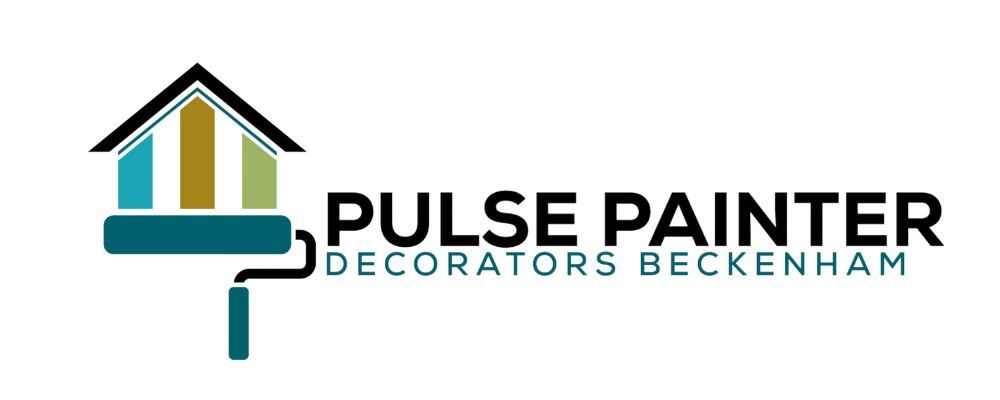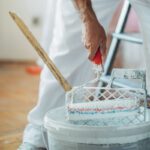Picture this: you’re standing outside your home, examining its exterior. The paint is peeling, faded and worn out. It’s time for a fresh coat of paint to give your home a new lease of life.
But with so many options available in the market, how do you choose the right exterior paint for different surfaces in the UK?
Choosing the right exterior paint for different surfaces can be overwhelming, but it doesn’t have to be. Just like selecting an outfit for a special occasion or choosing the perfect shade of lipstick that complements your skin tone, selecting the right exterior paint requires careful consideration and knowledge about what works best for each surface.
In this article, we’ll guide you through everything you need to know about choosing the right exterior paint – from understanding different types of paints to preparing surfaces and deciding whether to hire a professional or tackle it yourself.
Let’s dive in!
Understand the Different Types of Exterior Paint
Let’s dive into the various types of exterior paint so you can envision which product will best suit your surfaces. Understanding the differentiating finishes is important when choosing the right brand of exterior paint.
There are three main types of finishes: flat, satin, and glossy. Flat finish is ideal for hiding imperfections because it doesn’t reflect light; however, it isn’t very durable and can be difficult to clean. Satin finish has a low sheen and is easier to clean than flat finish. It’s also more durable, making it perfect for high-traffic areas like doors and windowsills. Glossy finish, on the other hand, reflects light and gives a sleek appearance that makes details stand out. However, it requires more maintenance as dirt and imperfections are easily visible.
When deciding on a brand of exterior paint, look for companies that specialize in outdoor paints as they have formulations specifically designed to withstand harsh weather conditions. Some popular brands include Sherwin Williams, Benjamin Moore, Behr Marquee, Valspar Duramax, and Dulux Weathershield. Each comes with their own unique set of features such as UV protection or moisture resistance, so take time to research before purchasing.
Consider the type of surface you’ll be painting next by analyzing its texture and porosity so you can select the appropriate primer before applying your chosen paint color.
Consider the Type of Surface
When it comes to painting the exterior of your home, it’s important to think about what type of surface you’ll be working with. Different surfaces require different preparation and paint application techniques in order for the paint to adhere properly and last longer.
For example, wood surfaces should be sanded and primed before applying any paint, while concrete surfaces need to be cleaned thoroughly to remove any dirt or debris. Surface preparation is crucial when it comes to achieving a long-lasting finish.
It ensures that the surface is clean, smooth, and free from any imperfections that could affect the quality of the final outcome. By taking the time to prepare your surface properly, you can ensure that your chosen exterior paint will adhere well and give your home a fresh new look.
As you move on to determining the level of protection needed, consider how much exposure your surface will have to weather conditions like rain or sun damage.
Determine the Level of Protection Needed
Before diving into your exterior paint project, it’s important to consider the level of protection required for your surface. Different surfaces require different finishes and levels of protection.
For example, wood requires a paint that’s flexible enough to expand and contract with changing weather conditions. Masonry, on the other hand, needs a breathable paint that allows moisture to escape.
Choosing finishes can also affect the level of protection needed for your surface. Glossy finishes offer better durability but may not be suitable for certain surfaces like rough textures or areas prone to chipping. Matte finishes are cost-effective options but may not provide as much protection compared to glossier paints.
Consider these factors when selecting an exterior paint to ensure you get the right level of protection for your surface without breaking the bank. With this in mind, let’s move on to choosing the right color for your project.
Choose the Right Color
When choosing the right color for your exterior paint, consider the style of your home. A modern-style house may look best with a crisp white or bold black, while a Victorian-style home may benefit from softer pastel shades.
Complementing the surrounding environment, such as foliage or other buildings nearby, can also help guide your color choice.
Additionally, it’s important to consider the climate – lighter colors reflect heat and can be cooler in hot climates, while darker colors absorb heat and may not be suitable for warmer regions.
Consider the Style of Your Home
As you’re thinking about the style of your home, you’ll want to consider how different exterior paint colors and finishes will complement its unique features and architecture. For example, modern homes with clean lines and minimal ornamentation often look best in bold, contrasting colors that emphasize their simplicity and sophistication. Meanwhile, traditional homes with more elaborate details may benefit from softer, more muted hues that highlight their intricate design elements.
To select the right exterior paint for your home’s style, keep these factors in mind:
- Look at the architectural style of your home: Does it have a specific era or design movement associated with it? Consider researching color palettes that were popular during that time period.
- Pay attention to the shape and size of your home: Certain colors can make a house appear larger or smaller than it actually is. You’ll also want to choose a color scheme that complements any unique features such as gables or porches.
- Think about the materials used on your home’s exterior: Brick, stucco, wood siding – each material has its own texture and natural color variations. Make sure you choose an exterior paint that works well with these existing elements.
- Take into account any surrounding landscaping or foliage: The colors you choose should complement rather than clash with any trees, shrubs or flowers in your yard.
By taking all of these factors into consideration when selecting an exterior paint color for your home’s style, you can ensure that it’ll stand out beautifully while still blending seamlessly into its surroundings.
Complement the Surrounding Environment
To truly enhance your home’s exterior, it’s important to consider how the surrounding environment can impact your color choices. Nature inspired shades that complement the surrounding greenery can make a huge difference in improving the overall aesthetic appeal of your home. Color psychology plays an important role as well – warm, earthy tones are perfect for homes surrounded by nature.
Choosing colors that blend in with the environment can help create a cohesive look and feel for your home. It also adds to its curb appeal and makes it stand out from other homes in the neighborhood. Keep this factor in mind when selecting exterior paint colors and you’ll be on your way to creating a beautiful, harmonious space that blends effortlessly with its surroundings.
Moving forward, let’s consider another important aspect when choosing an exterior paint – considering the climate.
Consider the Climate
Considering the climate is crucial when picking colors for your home’s exterior, as certain hues may fade or become damaged in extreme weather conditions. For instance, if you live in an area with hot and dry summers, it’s best to choose paints that can withstand prolonged exposure to sunlight.
On the other hand, if you reside in a region with high humidity levels or frequent rainfall, opt for coatings that are resistant to mold and mildew growth. Moreover, it’s essential to select a paint that has sufficient durability for your environment.
In areas prone to heavy rains or snowfall, use coatings that can resist water damage and prevent erosion of the painted surface. Additionally, consider application techniques and drying time when painting during different seasons. For example, if you’re painting during summer months where temperatures are high, make sure to choose a paint with a fast-drying formula and avoid applying it during peak sun hours.
As you move on to prepare the surface of your home before painting, keep in mind that proper preparation is essential for achieving long-lasting results.
Prepare the Surface
Get your surface ready by giving it a good clean before applying any paint, so that it’ll look its best when the job is done. Surface cleaning is an essential part of preparing any exterior surface for painting.
Before you start, make sure to remove all dirt and debris from the surface using a pressure washer or scrub brush. Additionally, if there are any loose or flaky bits of old paint on the surface, these should be removed as well.
Once the surface is clean and dry, it’s time to consider priming techniques. Priming helps ensure that the paint adheres properly to the surface and can also help prevent stains from bleeding through.
Common surface preparation mistakes include not cleaning thoroughly enough, skipping primer altogether, or using an inappropriate type of primer for the specific surface material. By taking time to prepare your surfaces correctly, you’ll achieve better results with your exterior painting project.
When you’ve finished prepping your surfaces for painting, you may be wondering whether to hire a professional or tackle the job yourself.
Hire a Professional or DIY
Hiring a professional for your exterior painting project can save you time and stress, allowing you to sit back and relax while the experts transform your home’s appearance. While it may be tempting to take on the task yourself in order to save money, there are many benefits to hiring a professional painter.
DIY vs professional is a common dilemma that homeowners face when considering an exterior paint job. While DIY may seem like the cheaper option initially, it can end up costing more in the long run if mistakes are made or if the finish doesn’t hold up as well over time.
A professional painter will have experience with different types of surfaces and know which paints work best for each one, ensuring a high-quality and long-lasting finish. Additionally, professionals have access to specialized tools and equipment that DIYers may not have, which can make the job quicker and easier overall.
When comparing cost between DIY vs professional, it’s important to consider not just the initial cost but also any potential costs down the line due to mistakes or poor quality workmanship.
Frequently Asked Questions
Can I use the same type of exterior paint for different surfaces?
To ensure surface compatibility and paint durability, it’s best to use the appropriate exterior paint for each surface. Using the same type of paint for different surfaces may result in poor adhesion and premature peeling or fading.
How long does exterior paint last before it needs to be repainted?
It’s important to note that exterior paint longevity can vary due to several factors. Proper surface preparation is crucial for achieving optimal results. Generally, exterior paint lasts between five to ten years before needing to be repainted.
Is it necessary to use primer before applying exterior paint?
Using primer before applying exterior paint has pros and cons. It helps the paint adhere better, but can add extra time and cost. Alternatives to using primer include self-priming paints or skipping it altogether on certain surfaces.
Does the weather condition affect the application of exterior paint?
The weather condition can impact the application of exterior paint. It is best to apply paint on dry days with low humidity and moderate temperatures. Follow manufacturer’s recommendations for application tips to ensure proper adhesion and longevity of the paint.
Can I mix different colors of exterior paint to create a custom shade?
Yes, you can mix different colors of exterior paint to create a custom shade. Use mixing techniques and color matching for best results. Remember to measure and keep track of the proportions used for future reference.











